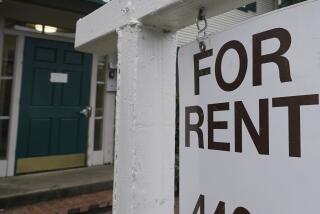Using Section 8 Vouchers to Buy a Home
- Share via
WASHINGTON — More than 1 million “working families” will be able to join the ranks of homeowners under a new program that allows them to use their rental assistance to purchase houses.
Beginning this month, people receiving rental-assistance vouchers under the federal Section 8 program can use the vouchers to buy a new home, an existing house or shares in a cooperative.
A dozen families already have purchased houses using their vouchers during the program’s pilot phase.
“Homeownership is the best way to build strong, vital neighborhoods,” said Andrew Cuomo, secretary of Housing and Urban Development, who announced the new venture at a speech in New York at Columbia University.
“This program makes good sense. If a person can pay a mortgage for the same amount or less than they could pay for rent, why not help them?”
The program will be administered by the nation’s 27,000 public housing agencies, which will determine eligibility and enforce the rules. HUD recently awarded 60,000 new rental vouchers to some 500 housing authorities that may be used for the new ownership program.
Vouchers may be used to make the monthly payments for 15 years if the mortgage is 20 years or longer, and up to 10 years if the loan is of shorter duration.
The voucher amount will be the same as what the family would receive in rental assistance. But to increase their buying power, local and state community development block-grant funds or other subsidies can be used in conjunction with the program.
If a family sells or refinances during the program’s initial 10 years, a portion of the home’s equity must be returned to their local housing authority. If a family defaults on the mortgage while in the program, they still may be eligible for rental aid, but the ownership plan no longer will be an option.
*
To qualify, a family must not only be eligible for Section 8 vouchers but also must be first-time buyers. No family member can have been an owner for at least three years before receiving ownership assistance, and no one may have an interest in another home while receiving aid.
Also, the family must have an annual household income of at least $10,300. Welfare income will be counted toward the minium for elderly and disabled buyers but no one else. Except for the elderly or disabled, the family also must have at least one adult member who has been employed full-time for a year.
Before receiving the government’s support, the family is required to attend counseling sessions to obtain a better understanding of all that ownership entails, including financing, maintenance, money management and fair housing laws. Families may also be required to participate in post-purchase counseling as well. But there will be no charge for any session.
Participants will be responsible for choosing their own lenders. But the housing authority may review the lender’s qualifications and its loan terms before approving assistance, and may reject the application if either the lender or the loan doesn’t meet its standards.
In addition, two inspections will be required: one by the housing authority to ensure that the house meets certain standards, and the other by an independent, certified home inspector, selected and paid for by the buyer, to identify any repairs that may be necessary.
*
Lew Sichelman can be contacted via e-mail at LSichelman@aol.com.
More to Read
Sign up for Essential California
The most important California stories and recommendations in your inbox every morning.
You may occasionally receive promotional content from the Los Angeles Times.













